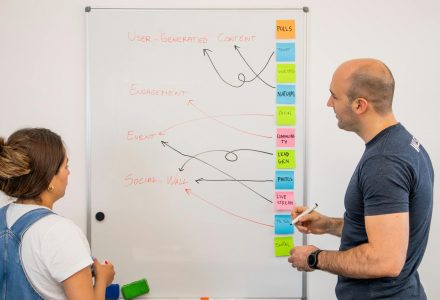Many B2B tech-based businesses are now adopting the SaaS, recurring revenue model due to one simple reason: it is now the best way to generate revenue with as little overhead as possible. From a customer’s point of view, the SaaS model can also allow them to get an otherwise very expensive software solution for a fraction of the actual cost, paid monthly or annually, so it’s a win-win situation.
However, while the B2B SaaS business model is definitely a thing, how we can market the product is another story. Due to the unique nature of the business model itself, however, marketing in these B2B SaaS businesses can be tricky. Convincing a potential client that your SaaS solution deserves to be an integral part of their business can be very challenging if you don’t know what you’re doing.
With that being said, here we will discuss all the ins and outs of B2B SaaS marketing, and how you can implement it to boost your SaaS revenue in no time.
Let us begin.
What Is B2B SaaS?
SaaS stands for Software as a Service, and is a business/distribution model in which a software provider hosts the software solution in the cloud and makes it available to customers over the internet. Typically the users of the software wouldn’t need to download and install the software, and they can use it directly via a web application
In the case of B2B SaaS, it is a software solution with other businesses as its customer and not the end-users of the software. A B2B SaaS product is typically designed to assist the business functions in whether to produce a more efficient operation or to improve revenue.
Adobe with its Creative Suite, and Google with Google Suite, are two examples of B2B SaaS businesses.
Why B2B SaaS Marketing Is Unique?
As discussed, B2B SaaS marketing is unique compared to any other industry because B2B SaaS is already very unique as an industry in at least three different ways:
1. Marketing intangible product
It’s quite obvious that selling a software product is very different than selling a physical product. In this age of social media, for example, a common marketing approach is to ask an Instagram influencer to promote/review the physical product with visual content. While we can use the same approach with a SaaS product, it’s much more difficult to execute and might not be as effective.
A key aspect to consider is that SaaS marketing is highly dependent on information and content. This is why many of the market leaders in SaaS—both B2B and B2C—like HubSpot, Moz, and others, have very strong content marketing game.
We can even argue that in SaaS marketing, content/information is just as, if not even more important than the SaaS product itself.
Another important consideration is that in today’s SaaS industry, a product-led approach is preferred: the marketing experience should be packaged in a way that highlights the product at the center while placing the customer at the center of the product.
2. Sales cycle
While B2B businesses typically involve relatively long sales cycles, in B2B SaaS, the sales cycle is very short.
A typical purchase decision process in B2B SaaS is:
- A client (an employee/manager in a company) needs a solution, and they do online research to solve this problem (or ask their friends, watch YouTube videos)
- They stumble upon possible SaaS solutions during this research
- They might compare the SaaS product with several competitors
- They decide on a solution and discuss it with other stakeholders in the company (finance managers, CEO, etc.)
- They purchase the product
The whole process might take just a few days or even within one day if you are selling a fairly affordable SaaS solution. Of course, there are various factors that might lengthen or shorten the sales cycle, but the fact remains that in B2B SaaS, the average sales cycle is relatively shorter than other B2B businesses.
B2B SaaS marketing strategy must take account of this shorter sales cycle and provide as much information as early as possible to convince the potential prospects. Timing is key.
3. Your job doesn’t end with a purchase
In SaaS recurring revenue model, you are selling your software for just a fraction of the COGS (cost of goods sold), so when you make the initial sale, in most cases you won’t recoup your cost yet. So, if you are using a monthly revenue model and a customer cancels after just a month of subscription, you are at a loss.
Meaning, maintaining customer retention is also a part of the B2B SaaS marketing strategy, and your job doesn’t stop with a conversion.
With that being said, the SaaS business process consists of three distinct phases:
- Lead generation: attracting visitors to our platform and convert them into prospects
- Customer acquisition/monetization: converting prospects into paying (subscribing) customers
- Customer retention: convincing these subscribers to stay with your service
In other industries and business models, acquisition tends to be the main, if not the sole focus. Using the same approach can be a huge mistake in B2B SaaS marketing.
8 Strategies Every Successful B2B SaaS Businesses Users To Generate Leads and Sales
1. Free-Trial and Product-Led User Experience
Another unique thing in SaaS marketing is that giving away your full product for free is a common practice, and can be one of the best and fastest ways to generate leads in the B2B SaaS industry.
Free-trial and/or Freemium are two examples of product-led marketing strategies: they show the product instead of telling your customers about the product. In offering your free-trial, there are several approaches you can try:
Free-trial:
In this approach, you offer full access to your full product for a limited period of time. You can let users sign up for the free trial with our without including their payment (credit card) information, but you have to capture their contact information, at least their email address.
Typically an opt-in free-trial (not requiring credit card/payment information) is preferred by customers nowadays since it provides an extra sense of accessibility.
Freemium:
Offering a basic (restricted/cut-down) version of your product for free, and then you can offer a premium, paid version without the limitations. The limitations can be:
- Advertisement: you might or might not remove functionality, but include advertisements in the free version (which can be an extra source of income for your)
- Limiting features: the most common approach in the freemium model, where we can lock certain features and/or functions. We can also limit storage/server access or limit the number of users.
- Cross-sells: the product itself is free, but we include another product that might encourage future purchases (i.e. an iPhone with iTunes (free) and iCloud (potential fees)
We can also combine both free-trial and freemium approaches to create a hybrid strategy. For example, we can offer a 30-day free trial for a brand new user. If this user hasn’t converted to the full version after 30 days, then we can offer a freemium version with feature limitations.
Based on the Product-Led principle, this user has experienced the full product before, and now they will feel the limitations of the freemium product. So, they might be more encouraged to convert.
Onboarding in B2B SaaS
Product onboarding, in a nutshell, is a theoretical stage in the product adoption process where customers have familiarized themselves with a product, learn the key features, and naturally develop the first impression of this product.
In SaaS and especially B2B Saas, onboarding is extremely important to a product’s success, without it most SaaS products lose 75% of their new acquisitions within a week. However, onboarding in SaaS can be a very challenging process, and so here are five actionable tips you can try to ensure a positive onboarding experience:
- Make it as easy as possible to understand and enjoy your SaaS product. Break everything down into small steps and make your tutorials as fun as possible. This will prevent your users from becoming overwhelmed and quit during the trial period. Using smaller steps will give your users a chance to feel accomplished with your product while finding practical solutions for their problems and/or fulfill their objectives.
- Streamline everything. Remove everything you don’t need, and only focus on key items that are crucial to delivering value. Don’t include too many steps in the lead capturing process. For example, you might not need their physical address right away and if you can, don’t require credit card information in your free trial campaign.
- Customer service excellence. Don’t forget the ‘Service’ aspect of SaaS, and you should provide excellent customer service even when they are still using the free version of your product or currently in the free trial period.
- Be transparent and set the expectation: During sign-ups, users and prospects want to know exactly where they are in the process, and how much they have left to go. Try to be transparent in every aspect of the onboarding process at all times.
- Personalization: Use product-led analytics to develop personalized user experiences for your users. For example, you should reach out differently to a user who spends more than 30 minutes with your product in their first two days compared to someone who hasn’t opened the app at all after the free trial sign-up.
2. Conversion-Optimized Website (UI/UX Optimization)
The most important principle regarding UI/UX in B2B SaaS website is to make it as easy as possible for customers to:
- Become aware of your SaaS product
- Learn about your product
- Understand how your product can help them solve their problem
- Get started with your product
If you can communicate this in your site’s interface and overall UX, you can generate a lot of conversions. However, this can be easier said than done, and here are some key areas to consider regarding conversion-optimized UX:
- Most websites that are considered ‘good’ in UX these days adopt a minimalist approach. This is especially important when you are trying to educate prospects about your products: don’t give rooms for distractions. So, don’t include anything that’s not necessary. If you think something doesn’t need to be there, it probably doesn’t.
- Personalized, both in design and content. You should demonstrate that you are a brand that knows its target audience, their needs, their problems, and you are the solution.
- Clear brand personality. The more unique and clear your brand messages are, the more memorable your site will be, and the more likely you can keep visitors and convert them.
3. Importance of First Impressions and Great Copy
As we’ve discussed above, how you convey information will make or break your B2B SaaS business.
Here are some key questions to ask:
- Do your headlines make sense to your target audience? Do they align well with your product?
Headlines are very important in whether you can capture your target audience’s attention or not.
Make sure to identify your brand’s purpose for the content, and focus on addressing why your target audience would consume this content. Make sure these headlines align well with your SaaS product, and if you can, communicate how your product can solve your target audience’s problems.
- Are your CTAs clear and to-the-point?
A call to action (CTA) is phrases and words that tell your audience to take a specific action. So, make sure your CTA is concise and clear, and eliminate extra thinking out of the equation. Make it as easy as possible for them to take the next action, and include as few steps as possible.
- Are users getting distracted?
Eliminate distractions as well as you can throughout your content. Let them focus on your product and its benefits, and prevent them from thinking about what steps they need to take next.
4. Providing Value Via Content Marketing
As we’ve discussed above, content marketing is very important in any SaaS marketing, and your SaaS product is only as powerful as your content.
Essentially, a consistent publication of high-quality, relevant content can allow you to establish your position as the thought leader/expert of your niche, building credibility that your brand is indeed a credible solution for your target audience’s problem. Content marketing is how you will convince your potential prospects that you are indeed the right partner for their businesses.
In B2B SaaS marketing, content marketing works with the inbound marketing principle: we are attracting our prospects inwards instead of pushing our messages onwards. This is done by having a relevant, valuable content available when our target audience is searching for information/solution. So, content marketing in B2B SaaS can be divided into three stages:
- Publication of relevant, high-quality content according to your target audience’s needs. This is done by performing keyword research before we develop our content to target keywords with high search volume that are often searched by our ideal audience.
- Content promotion. How we promote our content is very important. Just as, if not even more important than content development itself. We should utilize various available channels from email marketing, social media, influencer marketing, guest posting, and so on to get more traffic to our content, as well as to generate more backlinks.
- SEO. Since SEO is a pretty wide subject on its own, we will discuss it in its own section below.
5. SEO (Search Engine Optimization)
SEO will be our main way to promote our content and is the second aspect of the inbound marketing principle. With SEO implementations, we can get our content ranked high enough on Google’s (and other search engines’) SERPs, and we can generate organic traffic to the content.
Although SEO might seem pretty complex at first glance, the steps required to implement SEO is pretty simple:
-
- Create high-quality content. No amount of SEO optimizations can help low-quality, spammy content, and on the other hand, the quality and relevance of your content are the most important factors affecting SEO success.
- Optimize your content for keywords: Based on your keyword research, include the target keywords naturally within your content. You should also optimize your headlines/titles (including subheadings), META description, and URL with your target keyword.
- Optimize technical on-site factors: Technical on-site optimization can be pretty complex, and you can follow a technical SEO checklist to help you. However, focus on ensuring the mobile-friendliness of your site, optimizing your page speed, and your overall user experience.
- Generate more backlinks (off-site SEO): Backlinks remain the most important ranking factor in SEO, but generating high-quality backlinks can be easier said than done. The basic principle, again, is to have high-quality content and to include something linkable in your content including:
- Unique data/information (research report, white paper, etc.)
- Visually pleasing assets (images, photos, etc.)
- Interesting story
- And so on, in short, give them a reason to link you
Do these four steps consistently, and your page will slowly climb the SERP.
6. Retargeting/Remarketing
Although in the above tips we have been focusing on organic marketing efforts, paid ads are still one of the best ways to generate traffic and quick results.
In general, we can think of organic efforts VS paid ads as the case of cost vs time: organic efforts like content marketing or SEO are affordable, if not totally free when done right, but it will take some time before you can get the desired results (can be months and even years). On the other hand, paid ads and other paid promotional channels can generate instant results, but they can be very expensive if you are not careful.
So, in utilizing paid ads, maintaining cost-efficiency is the most important consideration, and this is where retargeting comes in.
Retargeting is, in a nutshell, displaying your ads to those who have visited your site and/or have consumed your content. So, your ad is displayed to a highly-targeted audience with a high chance of converting.
7. Monitor Your Efforts With Analytics
Remember that in SaaS marketing, you also have to deal with maximizing retention and preventing churn, so B2B SaaS marketing can be a long-term game.
With that being said, monitoring your marketing progress via the right analytics tools is very important if you want to achieve success.
You should monitor at least the following metrics:
- Unique visitors: whether the number of unique visitors is growing according to your marketing investments.
- Lead generation: including those who give you their email and sign-up to your newsletter, signed up to your free trial campaign, and so on. You can further score/differentiate your leads to the following:
-
-
- Marketing qualified leads (MQL): contacts that have triggered multiple signals like downloading product information, visiting several content pages, or asked for a sales conversation
- Sales qualified leads (SQL): prospects who have fulfilled certain criteria/threshold like completing an online questionnaire, talked/meet with your sales representative, meet the required budget, etc.
-
- Conversion rate: the number of visitors who converted into leads, leads who converted into SQLs, SQLs who converted to customers, etc. along your sales funnel
- Churn rate: very important in B2B SaaS marketing, measured by calculating the number of customers churned as a percentage of all paying customers.
- MRR: monthly recurring revenue, the total revenue you get in a month
- CLV: customer lifetime value, the total revenue generated from a single customer over their relationship with your brand
- CAC: customer acquisition cost, the total cost of acquiring a single customer.
8. Utilize Email Marketing
Even with all the newer technologies and marketing channels, email marketing remains one of the best channels with one of the highest ROI.
In B2B SaaS marketing, email marketing is especially useful in lead nurturing and also to maximize the retention of existing customers.
In general, SaaS companies should send the following emails:
- Onboarding/welcoming email (for free trial registration, product demo, etc. )
- New product or new feature announcements
- New content (new blog posts)
- Company newsletters
- Conducting surveys and interviews
- Support/tutorial/education, etc.
End Words
Above, we have discussed 8 of the most effective B2B SaaS marketing strategies we can implement right away. It’s important to remember that there are three core stages of SaaS marketing: lead generation, customer acquisition, and customer retention, the latter is unique to the recurring revenue business model like B2B SaaS.
Since SaaS marketing can be a long-term game, it’s also important to consistently monitor your progress according to your objectives, and make adjustments when required.






